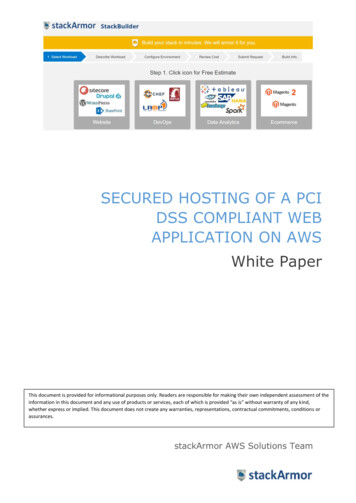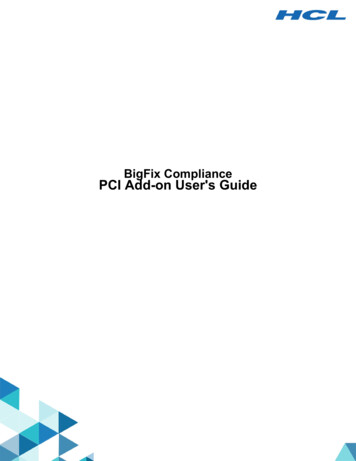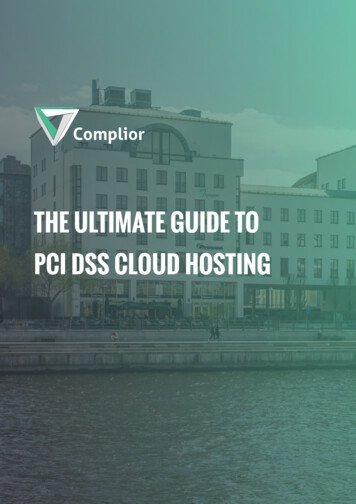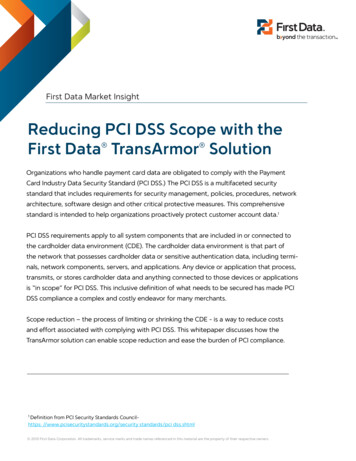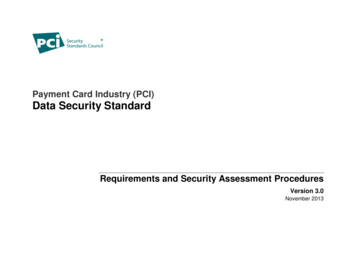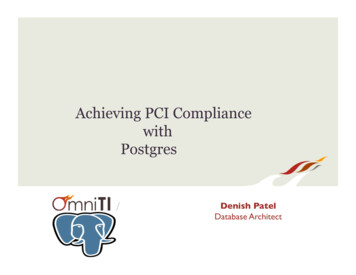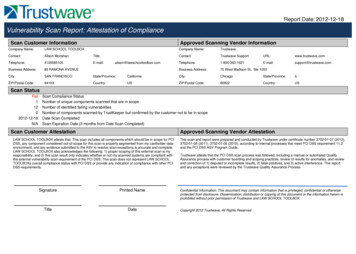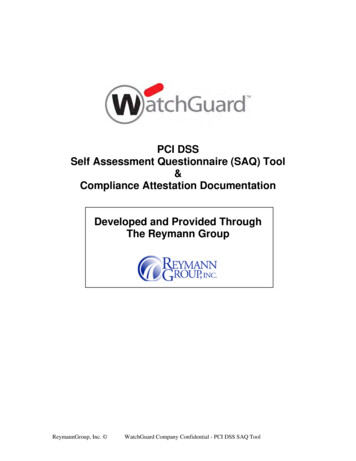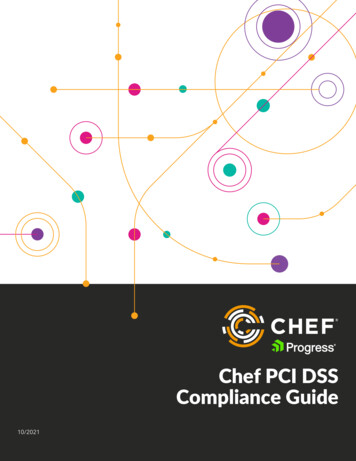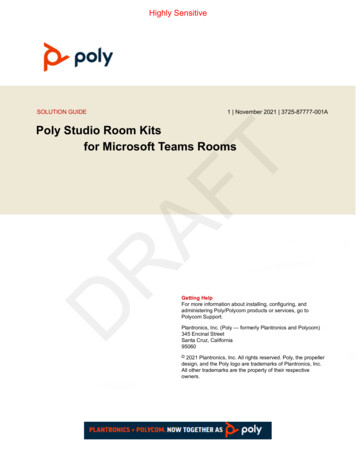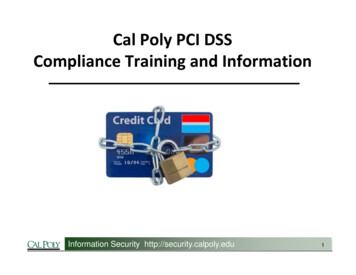
Transcription
Cal Poly PCI DSSCompliance Training and InformationInformation Security http://security.calpoly.edu1
Training Objectives Understanding PCI DSS– What is it?– How to comply with requirements Appropriate ways to handle payment cards– Protecting cardholders & Cal PolyInformation Security http://security.calpoly.edu2
Agenda Part 1: PCI DSS Compliance BasicsPart 2: PCI DSS Driving FactorsPart 3: Securing PCI Data – Why and How?Part 4: ReviewInformation Security http://security.calpoly.eduPage 3
Part 1PCI DSS Compliance BasicsInformation Security http://security.calpoly.eduPage 4
What is PCI DSS?PCI DSS Payment Card Industry Data Security Standard– The result of a collaboration between Visa, MasterCard,American Express, Discover, and JCB to create commonindustry security requirements.– Provides a baseline of technical and operationalrequirements designed to protect cardholder data.– Compliance is mandated for all organizations handling creditcard data.Information Security http://security.calpoly.eduPage 5
A Brief History of PCI DSS 2000 – Visa introduces cardholder information security program (CISP) for the USA 2001 – Visa Mandates CISP for all merchants 2000 – 2004: Other Card companies follow suit with their own programs (i.e. MasterCard's SDPprogram, Amex DSOP program, etc.) 2004 – Payment Card Industry (PCI) announces the Data Security Standard (DSS) 2005 – Card Brands begin mandating compliance with PCI DSS 2006 – PCI Security Standards Council is formed and PCI DSS v1.1 is released 2007 – New compliance deadlines set for Level 1 and Level 2 merchants 2007 – Fines for non‐compliance, starting 10/1/07 for Level 1 and 1/1/08 for Level 2 2008 – Visa issues Payment Application Security mandates with associated deadlines forcompliance 2009 – October, 2008: PCI DSS v1.2 is released 2009 – Fines for non compliance implemented for Level 3 merchants 2009 – MasterCard announces that, effective June 30, 2011, all Level 1 and Level 2 merchants doing aninternal audit or self assessment will need to have staff attend SSC sponsored PCI DSS trainingand maintain appropriate certifications 2010 – October, 2010: PCI DSS v2.0 is releasedInformation Security http://security.calpoly.eduPage 6
PCI Terms Payment cards – credit cards, debit cards, and other cardsthat facilitate cardholder payments Card present transactions – the cardholder presents theactual card to the merchant for processing. Usually swipedinto a register or terminal and a signature is obtained. Card not‐present transactions – the cardholder giveshis/her payment card information over the phone or sendshis/her card information on a designated form. A form mayinclude a signature, however, signatures are usually notobtained for this type of transaction.Information Security http://security.calpoly.eduPage 7
PCI Data Fields ‐ What can never be stored!Information Security http://security.calpoly.eduPage 8
What are the Requirements? PCI DSS is comprised of 12 high‐level requirements,which includes over 200 sub requirements (!)— https://www.pcisecuritystandards.org/security standards/index.php Requirement 12.6.1 is the mandate to educatepersonnel who handle credit cardholder informationupon hire and at least annually. In other words, thereason for this training. . .Information Security http://security.calpoly.eduPage 9
PCI Data Security Standard (DSS)12 High-Level requirements – deceptively simpleInformation Security http://security.calpoly.eduPage 10
What is in scope for PCI requirements? All personnel with access to cardholder data. All system components that capture, store, process, ortransmit cardholder data. This includes servers,workstations, network devices, and applications, alongwith anything on the same network segment.Information Security http://security.calpoly.edu11
Common PCI DSS Myths1. One vendor or product will make us compliant.— PCI DSS compliance is a layered process.2. Outsourcing card processing makes us compliant.— Not always (!)3. We have completed an SAQ, therefore we are compliant.— PCI DSS compliance is an ongoing process.4. We don’t take enough credit cards to have to be PCIcompliant.— PCI DSS compliance is required for any business that acceptspayment cards – even if the quantity of transactions is just one.Information Security http://security.calpoly.edu12
The Real StoryPCI DSS is an “All or Nothing” StandardA single requirement not being met Non‐complianceInformation Security http://security.calpoly.edu13
Click to edit Master title styleInformation Security http://security.calpoly.edu14
PCI DSS Compliance Implications PCI DSS compliance is clear in definition and beingenforced by the card brands. PCI DSS non‐compliance can result in consequencesthat have dramatic impact on your business. Significant fines for non‐compliance have been addedby the major card brands as of October 1, 2007.Information Security http://security.calpoly.edu15
Fines Issued for PCI Non-ComplianceInformation Security http://security.calpoly.edu16
Part 2What's Driving this Whole PCI DSSThing?Information Security http://security.calpoly.edu17
Business Drivers Behind PCI DSS Recognize organizational benefits Improve operational efficiencies Avoid potential breach fines or non‐compliance fees Achieve Safe Harbor1 status – consequences waived Maintain ability to continue processing credit cards Avoid cost of data breach Reduce risk – “Hacking” has become a profitable line of business fororganized crime1SafeHarbor status: Per Vista, Safe harbor Status requires that “A member, merchant, or serviceprovider must maintain full compliance at all times, including at the time breach asdemonstrated during the forensic investigation.”Information Security http://security.calpoly.edu18
PCI Vulnerabilities Exist at Many Levels Vulnerabilities in information security leave open doorsfor theft Vulnerabilities may appear almost anywhere in thecredit card processing ecosystem1: Point of Sale Devices Desktops/ Laptops Servers Wireless hotspots Web shopping applications Paper‐based storage systems Unsecured transmission of cardholder data Unsecured transmission of cardholder data toservice providers1PCISecurity Standards counsel (SSC) Data Security Standards (DSS) Quick reference GuideInformation Security http://security.calpoly.edu19
Credit Cards are Being Sold on the InternetInformation Security http://security.calpoly.edu20
Credit Card Data Beach ChronologyYear(s)Name of breached Entity# of Credit CardsCompromised20032003‐200420052005Data Processors IntlBJ’s WholesaleDSW ShoesCardsystems Solutions5 Million9.2 Million1.5 Million40 Million20072007Dai NipponFidelity (Certegy)8.6 Million8.5 Million2007Hannaford Brothers4.2 MillionHad to spend “millions” onsecurity upgrades2005‐2008TJX Companies54.7 Million2008‐20092009RBS WorldHeartland payment Solutions1.5 Million130 Million2011Sony24.6 MillionEstimated total losses 256M‐ 4.5BEstimated cost 90MRelated Expenses total 140M so far Estimated cost 171 MillionInformation Security http://security.calpoly.eduImpactCard processing rightrevoked. Went out ofbusiness as a result21
Part 3Securing PCI DataWhy and How?Information Security http://security.calpoly.edu22
The Challenge Ironically, the things that make our lifeeasier and more convenient also makecrime easier and more convenient.Information Security http://security.calpoly.edu23
Ongoing Campus PCI Efforts Quarterly computer scans Annual employee and student employee training ofPCI policies and security awareness Annual network penetration testing PCI DSS Assessment and report of compliance self‐assessment questionnaire (SAQ) form completionInformation Security http://security.calpoly.edu24
6 Main Goals of PCI‐DSS Build and maintain a secure network Protect cardholder data Maintain a Vulnerability Management Program Implement strong access control measures Regularly monitor and test networks Maintain an Information Security PolicyInformation Security http://security.calpoly.edu25
Meeting Our Goals Maintain a secure network through strong passwords Protect Cal Poly confidential data and your personalinformation Don’t email confidential information– Don’t respond to phishing messages Practice safe Web surfing– Don’t respond to pop‐up hoaxes Comply with physical security policies and procedures.Information Security http://security.calpoly.edu26
Use Strong Passwords Store your passwords encrypted. Keep your password private, don’t share it with co‐workers. No one at Cal Poly will ask you for your password. Your bank or any reputable company will never solicitthis information. If you are ever asked for your password in an email orover the phone – don’t give it out.Information Security http://security.calpoly.edu27
Protect Cardholder DataAs a custodian of customer information, it is your roleto protect cardholder data. If cardholder data iscompromised, the owner of the information suffersthe consequences, whether financial or byreputation. Cal Poly will ultimately face the sameconsequences.If you wouldn’t hand a stranger yourown credit card, then don’t hand themsomeone else’s!Information Security http://security.calpoly.edu28
Phishing Email Be wary of suspicious email messages. Don’t open email attachments unless you areexpecting them. E‐mails may include viruses or misleading links toweb pages which ask for personal information. Don’t click on URLs that people send you unless it isa known “safe” site. Report suspicious email to abuse@calpoly.edu.Information Security http://security.calpoly.edu29
Website Safety Malicious websites can be infected with spyware ormalware and can infect your computer when you visitthem.– Stay away from unknown sites or sites that anti‐virussoftware warns against. Be aware of “pop‐ups” that could contain spyware. Use known sites that are secure “https” for personalbusiness. Spyware and malware could allow an opening to stealconfidential information.Information Security http://security.calpoly.edu30
It’s Not Only Electronic Data Protect information in all its forms. Keep printed confidential information out of site. Use locks on cabinets and offices appropriately. Shred documents when they are no longer required. When speaking about a confidential matter, be surethat your conversation will not be overheard.Information Security http://security.calpoly.edu31
Primary Guiding Principle forCardholder DataIf you don’t absolutely need tostore it, DON’T!Information Security http://security.calpoly.edu32
Part 4We ALL Have a Role to Play toComply with PCI DSS.Information Security http://security.calpoly.edu33
Review The industry has mandated PCI DSS compliance withfines for non‐compliance. PCI‐DSS regulations applies to everyone who acceptscredit cards. Credit card fraud is a serious problem. Compliance with PCI DSS helps alleviatevulnerabilities and protect cardholder data.Information Security http://security.calpoly.edu34
Ways to Protect Cardholder Data Never share your password with anyone! Keep your desk clear of any sensitive materials. Always properly dispose of paper records withcardholder data, using cross‐cut shredders orapproved shredding bins. Don’t allow unauthorized individuals around PCIdevices. Be alert! If you’re unsure about what could be asecurity risk, ask your supervisor.Information Security http://security.calpoly.edu35
Helpful ResourcesLearning about information security and safe computing neednot be a daunting task. There are resources on campus to helpyou: Cal Poly Information Security Website— http://www.security.calpoly.edu/ Cal Poly Information Technology Services – Service Desk– http://www.servicedesk.calpoly.edu/ PCI Security Standards Council– http://www.pcisecuritystandards.orgReferences: Some content contributed by Halock Security Labs (Halock.com)Information Security http://security.calpoly.edu36
Common PCI DSS Myths 1. One vendor or product will make us compliant. —PCI DSS compliance is a layered process. 2. Outsourcing card processing makes us compliant. —Not always (!) 3. Wehave completed an SAQ, therefore weare compliant. —PCI DSS compliance is an ongoing process. 4.
